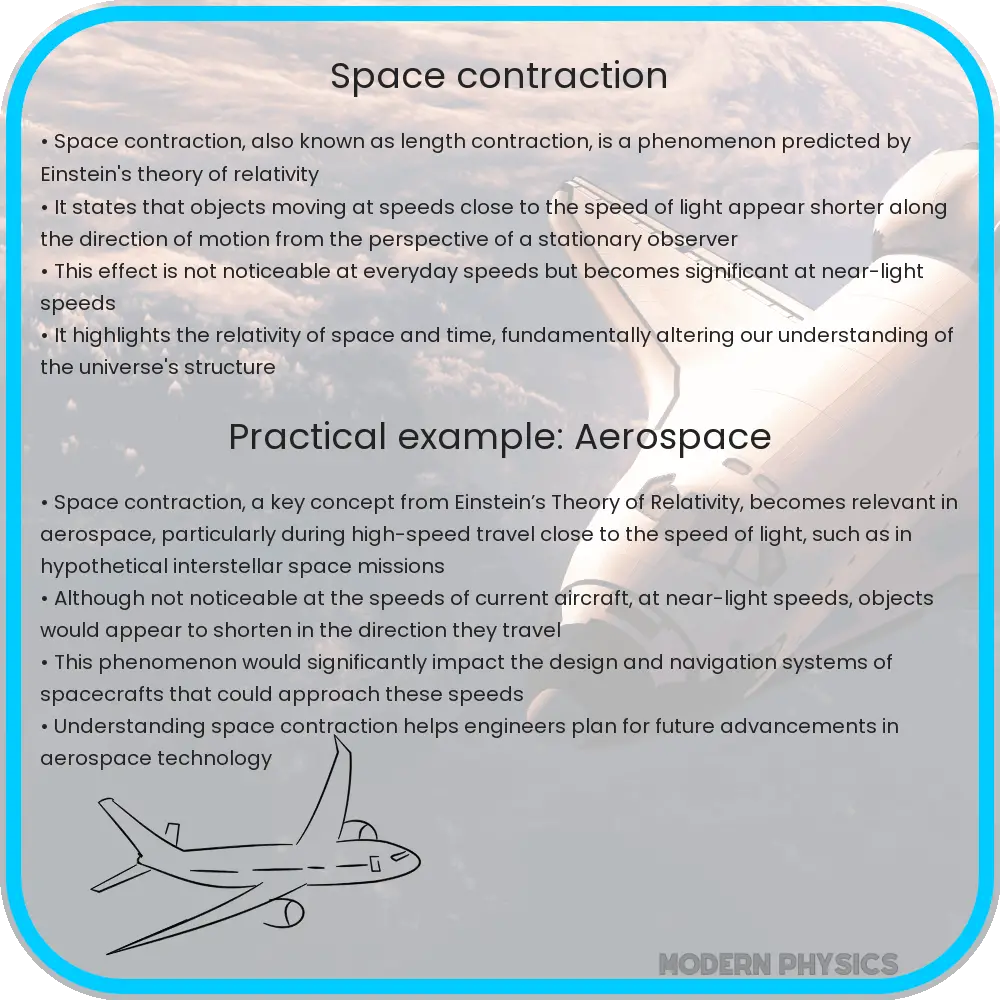Explore space contraction in special relativity: Discover Lorentz transformation, its implications in physics, and applications in technology.

Understanding Space Contraction in Special Relativity
Special relativity, a fundamental theory proposed by Albert Einstein in 1905, revolutionized our understanding of space and time. One of its most intriguing concepts is space contraction, also known as Lorentz contraction. This phenomenon describes how the length of an object in motion appears to contract from the viewpoint of a stationary observer.
The Lorentz Transformation
At the heart of space contraction lies the Lorentz transformation. This mathematical framework connects the space and time coordinates of two observers moving relative to each other at a constant velocity. The transformation is governed by the equation:
L = L0 / √(1 - v2/c2)
Here, L represents the contracted length, L0 is the object’s rest length, v is the relative velocity between the observer and the moving object, and c is the speed of light in vacuum.
Implications of Space Contraction
Space contraction has profound implications in physics. It challenges our intuitive understanding of space as a static and absolute entity. In special relativity, space and time are interwoven into a four-dimensional continuum known as spacetime. This interconnection means that the length of an object isn’t an absolute measure but depends on the observer’s state of motion.
Despite its counterintuitive nature, space contraction isn’t typically noticeable in everyday life. It becomes significant only at speeds approaching the speed of light. This is why the effects of special relativity were not observed until the advent of high-speed experiments in physics.
Experimental Verification
Space contraction isn’t just a theoretical curiosity; it has been experimentally verified. High-energy particle experiments, where particles travel at speeds close to the speed of light, provide real-world evidence of this phenomenon. Particle accelerators like the Large Hadron Collider (LHC) routinely observe the effects predicted by Lorentz contraction, further validating Einstein’s theory.
In conclusion, space contraction is a fascinating aspect of special relativity that has significant implications for our understanding of the universe. It exemplifies the revolutionary idea that the properties of space and time are relative, depending on the observer’s frame of reference.
Relativity in Astrophysics and Cosmology
Space contraction also plays a pivotal role in astrophysics and cosmology. It helps explain phenomena like the behavior of light around massive objects (gravitational lensing) and the dilation of time near a black hole. As we observe cosmic objects moving at significant fractions of the speed of light, special relativity provides essential insights into their behavior and properties.
Technological Applications
Beyond theoretical importance, the principles of special relativity, including space contraction, find applications in modern technology. One notable example is the Global Positioning System (GPS). GPS satellites orbit the Earth at high speeds and are subject to relativistic effects, including time dilation and space contraction. Accurate GPS functioning requires adjustments based on these relativistic principles to provide precise location data.
Challenging the Classical View
Space contraction, as a concept, fundamentally challenges the classical Newtonian mechanics, which viewed space and time as absolute and independent. Special relativity brought a paradigm shift, showing that our perceptions of length, time, and even mass are not fixed, but change relative to the observer’s velocity. This shift has profound philosophical implications, forcing us to reconsider our understanding of reality itself.
Conclusion
The concept of space contraction in special relativity is more than a century old, yet it continues to captivate and challenge physicists, philosophers, and the general public. Its implications extend from the minutiae of subatomic particles to the vastness of cosmic phenomena. Lorentz contraction is a cornerstone in our understanding of the universe, reminding us that reality is not always as it appears to our everyday experiences. As technology advances and allows us to explore higher speeds and more extreme conditions, the insights from special relativity will undoubtedly continue to guide us in unraveling the mysteries of the universe.
Special relativity, with its ideas of space contraction and time dilation, stands as one of the most successful theories in physics. It underscores the importance of continually questioning and testing our understanding of the natural world. As we delve deeper into the realms of quantum mechanics and cosmology, the principles of special relativity will remain crucial in our quest for a deeper and more comprehensive understanding of the cosmos.
